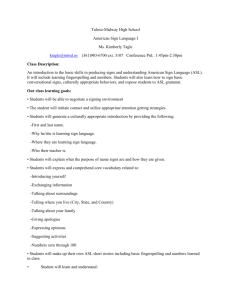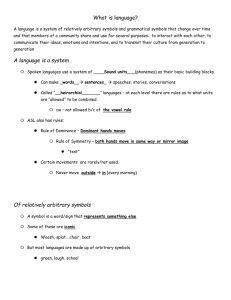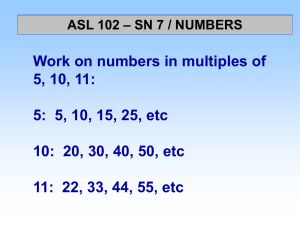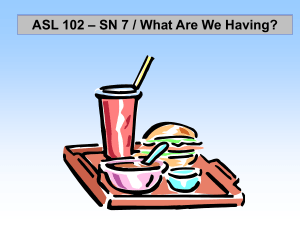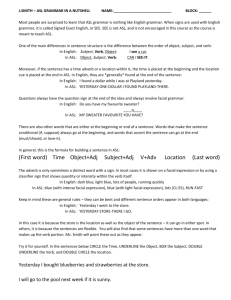Passive Voice: How is it Interpreted - NIC-Test-Prep-at
advertisement
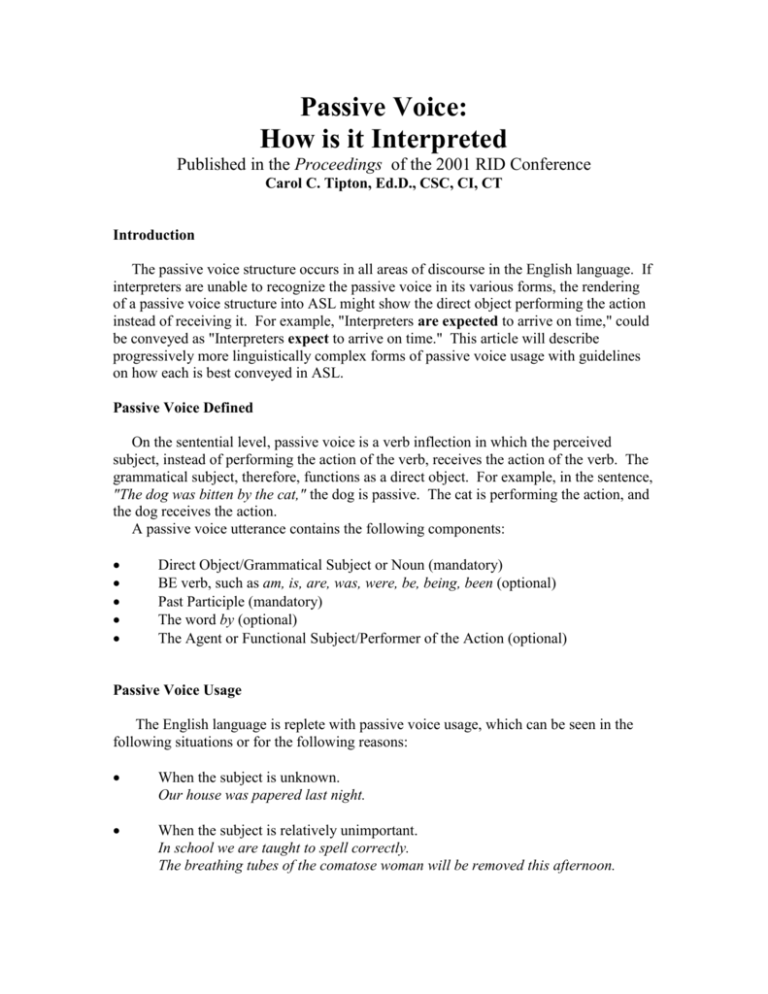
Passive Voice: How is it Interpreted Published in the Proceedings of the 2001 RID Conference Carol C. Tipton, Ed.D., CSC, CI, CT Introduction The passive voice structure occurs in all areas of discourse in the English language. If interpreters are unable to recognize the passive voice in its various forms, the rendering of a passive voice structure into ASL might show the direct object performing the action instead of receiving it. For example, "Interpreters are expected to arrive on time," could be conveyed as "Interpreters expect to arrive on time." This article will describe progressively more linguistically complex forms of passive voice usage with guidelines on how each is best conveyed in ASL. Passive Voice Defined On the sentential level, passive voice is a verb inflection in which the perceived subject, instead of performing the action of the verb, receives the action of the verb. The grammatical subject, therefore, functions as a direct object. For example, in the sentence, "The dog was bitten by the cat," the dog is passive. The cat is performing the action, and the dog receives the action. A passive voice utterance contains the following components: Direct Object/Grammatical Subject or Noun (mandatory) BE verb, such as am, is, are, was, were, be, being, been (optional) Past Participle (mandatory) The word by (optional) The Agent or Functional Subject/Performer of the Action (optional) Passive Voice Usage The English language is replete with passive voice usage, which can be seen in the following situations or for the following reasons: When the subject is unknown. Our house was papered last night. When the subject is relatively unimportant. In school we are taught to spell correctly. The breathing tubes of the comatose woman will be removed this afternoon. To avoid putting someone on the defensive, avoiding "you" statements. (to the janitor) My wastebasket has not been emptied for three days instead of You haven't emptied my wastebasket for three days. To make institutional or policy statements. Parking is permitted in all metered spaces. To avoid taking personal responsibility The report was inadvertently misfiled instead of I accidentally filed the report in the wrong location. How to Interpret Passive Voice The passive voice structure takes many forms in the English language, many of which will be described subsequently. The first step in effectively interpreting passive voice is to recognize it when it occurs. Failure to do so often results in showing the direct object performing the action instead of receiving it. Once a passive voice utterance is recognized, the techniques described here can be used to ensure that the object receives the action of the verb. Depending on the complexity of the utterance, these techniques may be used in combination or alone. After each technique, an example will be given, followed by a gloss of a suggested rendering into ASL*. This suggested rendering represents only one of several possible interpretations into ASL. Limited space precludes listing more than one. (*note: The author recognizes that because ASL does not have a standard written form, attempting to depict ASL by glosses is limited at best. Glosses are given from the perspective of a right handed signer.) When the agent is specified, usually with a "by" phrase, show that agent performing the action. Example: The house was purchased by a young couple. ASL: house, who buy?(RQ) couple young Put the object in sign space as a classifier and show the action happening to it. Example: That teacher is not liked. ASL: that teacher 1-CL(left) like? (the sign should move from the body toward the 1-CL accompanied by eye gaze) not If the interpreter signs, teacher not like, it appears that the teacher does not like something, as if the teacher is performing the action, instead of conveying the meaning that some other entity does not like the teacher. When the performer of the action is not specified, create a logical agent based on context. Example: The two boys were arrested yesterday. ASL: know boys two-of-them? yesterday police arrest 2 When the performer of the action is not specified, allow the signer to become an unspecified agent, performing the action. Example: That pill must be taken with water. ASL: that pill, do? must pop-in-mouth, water drink swallow Restructure the sentence. Example: The car was sold to me. ASL: car, me buy Passive Voice Structures and Suggested Interpretations into ASL Various passive voice forms, starting with the more obvious and moving into more complex, will now be listed and suggested renderings into ASL given. Standard Passive, which includes: Noun + Be Verb + Past Participle + BY + Agent Example: Tom Sawyer was written by Mark Twain. ASL: book title Tom Sawyer, who write? Mark Twain Example: The cars were washed by the tenth grade class. ASL: cars 3-CL+++, 10th grade class wash This structure can be interpreted fairly easily into ASL because it states the object first and can thereby follow the object-subject-verb structure of ASL. Standard Passive without the "BY" phrase In these utterances the agent, or who is performing the action, is unknown. Example: Children should never be spanked. ASL: child (in sign space lower than the signer) spank (show the signer performing the action) should? Never! Example: You are expected to keep your room clean. ASL: your room, keep clean, must (restructure) Example: The parents of the ADHD children were interviewed. ASL: children point-left have ADHD, their parents 2h5CL (in line slightly to the right) interview+++ (move from left to right down the line with eye gaze) Standard Passive without the "Be" phrase In this structure two sentences are merged into one, and the "be" verb is omitted. Example: The actor was chosen for that role. He had little previous experience. The actor chosen for that role had little previous experience. In rendering such a sentence into ASL, the interpreter may need to expand it back 3 to the two original sentences. ASL: actor 1-CL (left hand) choose (originate the sign at the classifier) for? that role (right). point-toward-classifier have much experience? no, little Example: Students allowed to drive can park in the upper lot. ASL: some student (face left) permit (direct it toward the students) drive. they park where? upper level park+++ Example: Opinions expressed on this program are not necessarily those of its sponsors. ASL: this program/show, people express different++ opinions. sponsors agree? not always Passive Gerunds A gerund is a verb form which functions as a noun. Example: The child enjoys being read to by her mother. ASL: mother book-open story+++, girl/child sit-beside watch enjoy Example: He hates being teased. ASL: boy 1-CL tease (directed toward the classifier) hates (a number of different signs could be used here but the one chosen should be directed toward the location in sign space where the sign for "tease" originated) Example: She wants to be asked to the prom. ASL: Girl point-left want someone invite (originating where the girl is located in sign space) go-to prom (move right) Passive Participial Adjectives A past participle can function as an adjective preceding a noun, e.g., lost boys, chosen people, stolen car. If an adjective describes a state of being, e.g., "frightened" means the same as "afraid", then it is a normal adjective and can be handled as such by an interpreter. If, however, it describes a state of becoming or of the noun being acted upon, it is a passive adjective and must be handled by expansion and deliberate use of space. Example: Leah was the unloved wife of Jacob. ASL: Leah, 1-CL (left) her husband Jacob love her? not Example: We stored the donated items in the garage. ASL: different+++ things (2 hands) people give+++ (directed toward the signer), put/store where? garage Example: Theirs was an arranged marriage. 4 ASL: two-of-them marry how? his mother father (left) her mother father (right) meeting discuss decide two-of-them marry Deep Structure Passives. Occasionally an utterance can only be recognized as passive by analyzing its deeper meaning because the surface structure does not follow the standard form for passives. Examine the following example: John is eager to please. John is easy to please. In the first example John is performing the action of pleasing while in the second others are performing the action of pleasing him. The first one is active, and the second passive. Consider the following examples: Pat is interested. Chris is excited. Lee is bored. Pat is interesting. Chris is exciting. Lee is boring. On the surface it would appear that the left-hand column could contain passive structures because of the presence of a past participle in each sentence. However, each example to the left describes how that person feels, and each past participle functions as a regular adjective. The right-hand examples describe how others, who are not specified, feel about each person. These examples need to be treated like passives in order to be interpreted accurately into ASL. In ASL each sentence might be rendered as follows: English Pat is interested . Pat is interesting. Chris is excited. Chris is exciting. Lee is bored. Lee is boring. ASL Pat eager Pat 1CL(left) interest(show the sign moving toward the classifier) Chris excited (use body shift to take on Chris’ demeanor) Chris influence-me, excite (meaning “I am excited by Chris.”) Lee bore Lee point bore person (eyegaze toward Lee) Review and Conclusion The following paragraph contains examples of passive voice usage. Try to identify each passive utterance and determine how it would best be conveyed in ASL. The paragraph will be repeated with passive structures italicized, and a possible interpretation for each given. "CEUs are awarded based on contact hours attended. This means that participants must sign in to each activity, verifying that they attended the hours indicated. For 5 most activities, participants will be awarded .1 CEU for every contact hour of participation documented by the Sponsors. One-half credit will be awarded to those who attended at least half...of an activity." (Diana Macdougall, "CMP Update", RID Views, February, 1999, p. 22) "CEUs are awarded based on contact hours attended. This means that participants must sign in to each activity, verifying that they attended the hours indicated. For most activities, participants will be awarded .1 CEU for every contact hour of participation documented by the Sponsors. One-half credit will be awarded to those who attended at least half...of an activity." CEUs are awarded ASL: CEU(close to body) give(away from body) The signer becomes the unspecified agent. ..hours attended ASL: hours you/they attend Add a logical agent. ..hours indicated ASL: hours you/they put-down Add a logical agent. participants will be awarded ASL: participants will receive Restructure. documented by Sponsors ASL: sponsors document/put-down Show the agent performing the action. one-half credit will be awarded ASL: 1/2 credit(close to body) give(from body) will The signer becomes the unspecified agent. Interpreters need to be aware of the various forms that the passive voice structure can take in English in order to accurately render the meaning into ASL. By studying the examples given above and practicing with material found elsewhere, interpreters can recognize passive voice utterances when they occur while interpreting and be able to process them in a way which preserves the original meaning. 6
